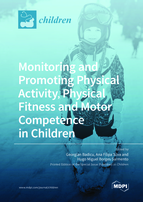Monitoring and Promoting Physical Activity, Physical Fitness and Motor Competence in Children
A special issue of Children (ISSN 2227-9067). This special issue belongs to the section "Global and Public Health".
Deadline for manuscript submissions: closed (15 August 2022) | Viewed by 55996
Special Issue Editors
Interests: physical activity; diet, fitness; sport; quality of life
Special Issues, Collections and Topics in MDPI journals
Interests: motor development; motor control and learning; exercise and brain function; sports training
Special Issues, Collections and Topics in MDPI journals
Interests: higher education; teacher education; behavioural science; sport psychology; qualitative social research
Special Issues, Collections and Topics in MDPI journals
Special Issue Information
Dear Colleagues,
It is our pleasure to have this Special Issue on ‘’Monitoring and Promoting Physical Activity, Physical Fitness and Motor Competence in Children’’ in the Children journal.
As we know, a large amount of research confirms that physical activity (PA), physical fitness (PF) and motor competence (MC) are associated with health benefits in individuals of all ages. Achieving a sufficient level of PA and PF will consequently further contribute to better health-related biomarkers. Moreover, holding a good MC allows better participation in PA and exercise in life, promoting greater physical literacy.
It is true that the measurement of PA in children and young people is subject to several conditioning factors which threaten validity and reliability. Additionally, it is good to remember that the World Health Organization guidelines on PA and sedentary behaviour for children recommend: (1) 180 min of PA (at any intensity) for two-year old children; (2) 180 min of PA, of which 60 min is moderate-to-vigorous physical activity (MVPA), for 3- to 4-year-old children; and (3) at least 60 min of MVPA for children and adolescents from 5 to 17 years old.
Therefore, understanding and developing strategies to promote PA behavior is now more important than in the past, because it is essential to improve fitness levels and MC in early ages. These strategies should cover all generations, children and youth, adults and the elderly, equally, because negative outcomes are visible in individuals of all ages.
In this Special Issue, we welcome contributions that describe and list the link, monitoring and promotion between PA, PF and MC. Your contribution is welcome in the form of an original article, case report, commentary, and systematic review with meta-analysis.
Dr. Georgian Badicu
Dr. Ana Filipa Silva
Dr. Hugo Miguel Borges Sarmento
Guest Editors
Manuscript Submission Information
Manuscripts should be submitted online at www.mdpi.com by registering and logging in to this website. Once you are registered, click here to go to the submission form. Manuscripts can be submitted until the deadline. All submissions that pass pre-check are peer-reviewed. Accepted papers will be published continuously in the journal (as soon as accepted) and will be listed together on the special issue website. Research articles, review articles as well as short communications are invited. For planned papers, a title and short abstract (about 100 words) can be sent to the Editorial Office for announcement on this website.
Submitted manuscripts should not have been published previously, nor be under consideration for publication elsewhere (except conference proceedings papers). All manuscripts are thoroughly refereed through a single-blind peer-review process. A guide for authors and other relevant information for submission of manuscripts is available on the Instructions for Authors page. Children is an international peer-reviewed open access monthly journal published by MDPI.
Please visit the Instructions for Authors page before submitting a manuscript. The Article Processing Charge (APC) for publication in this open access journal is 2400 CHF (Swiss Francs). Submitted papers should be well formatted and use good English. Authors may use MDPI's English editing service prior to publication or during author revisions.
Keywords
- physical activity
- physical fitness
- motor competence
- motor development
- children
- health
- monitoring and promoting
- sport
- sedentary behaviour
- obesity
- well-being









